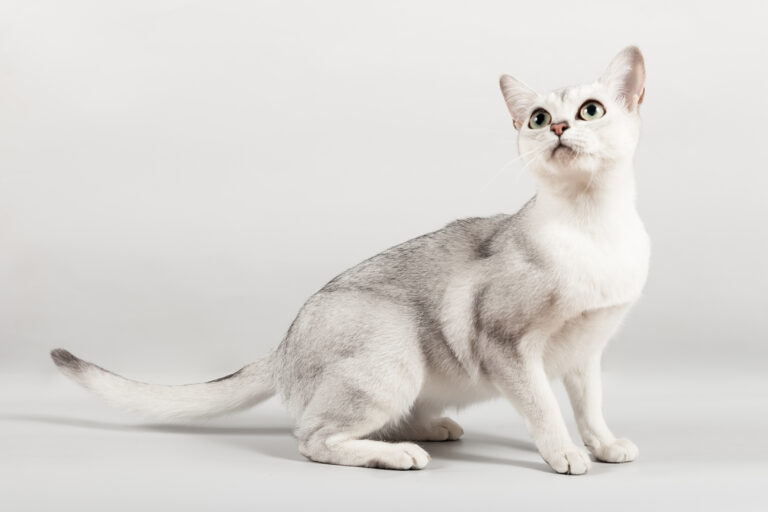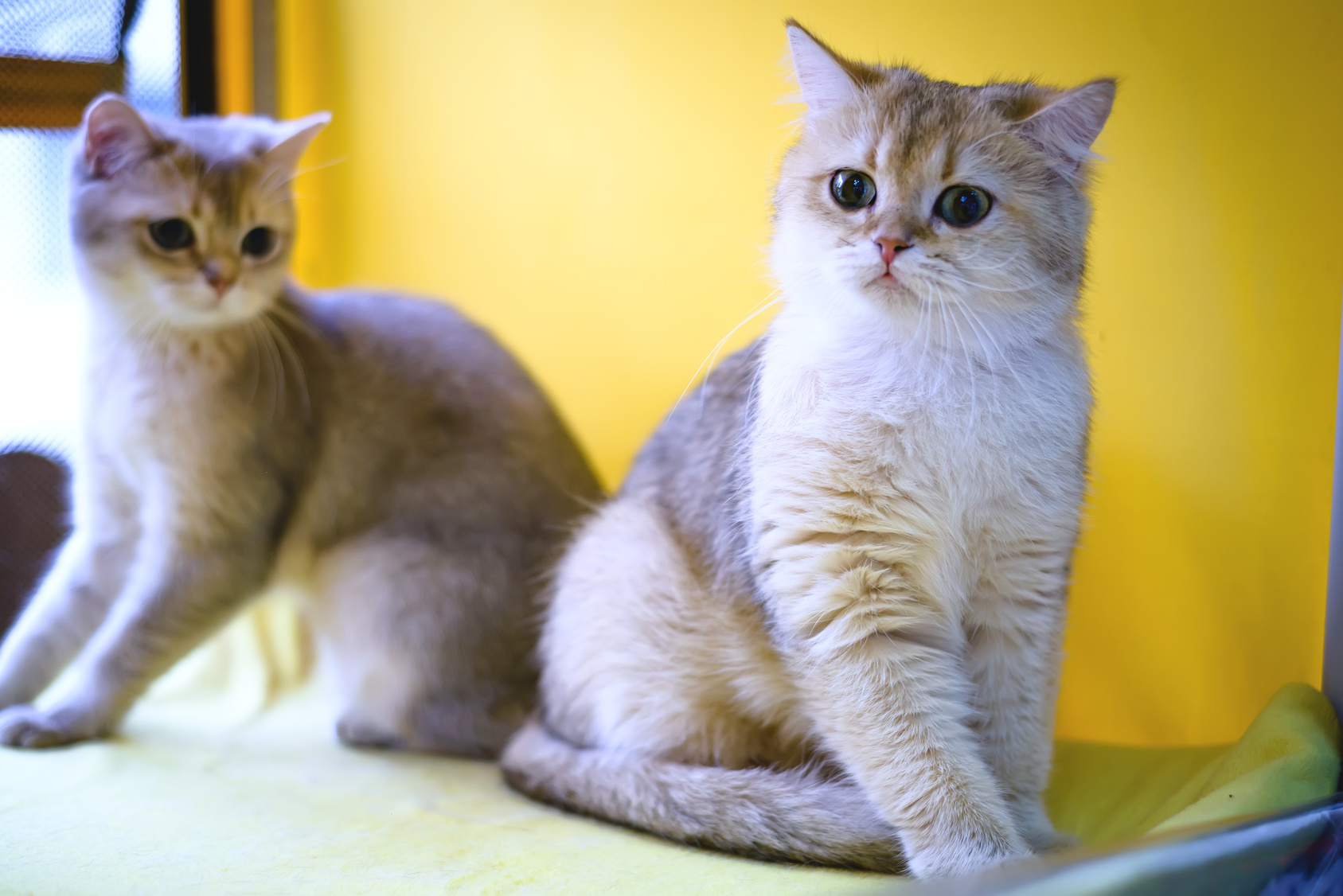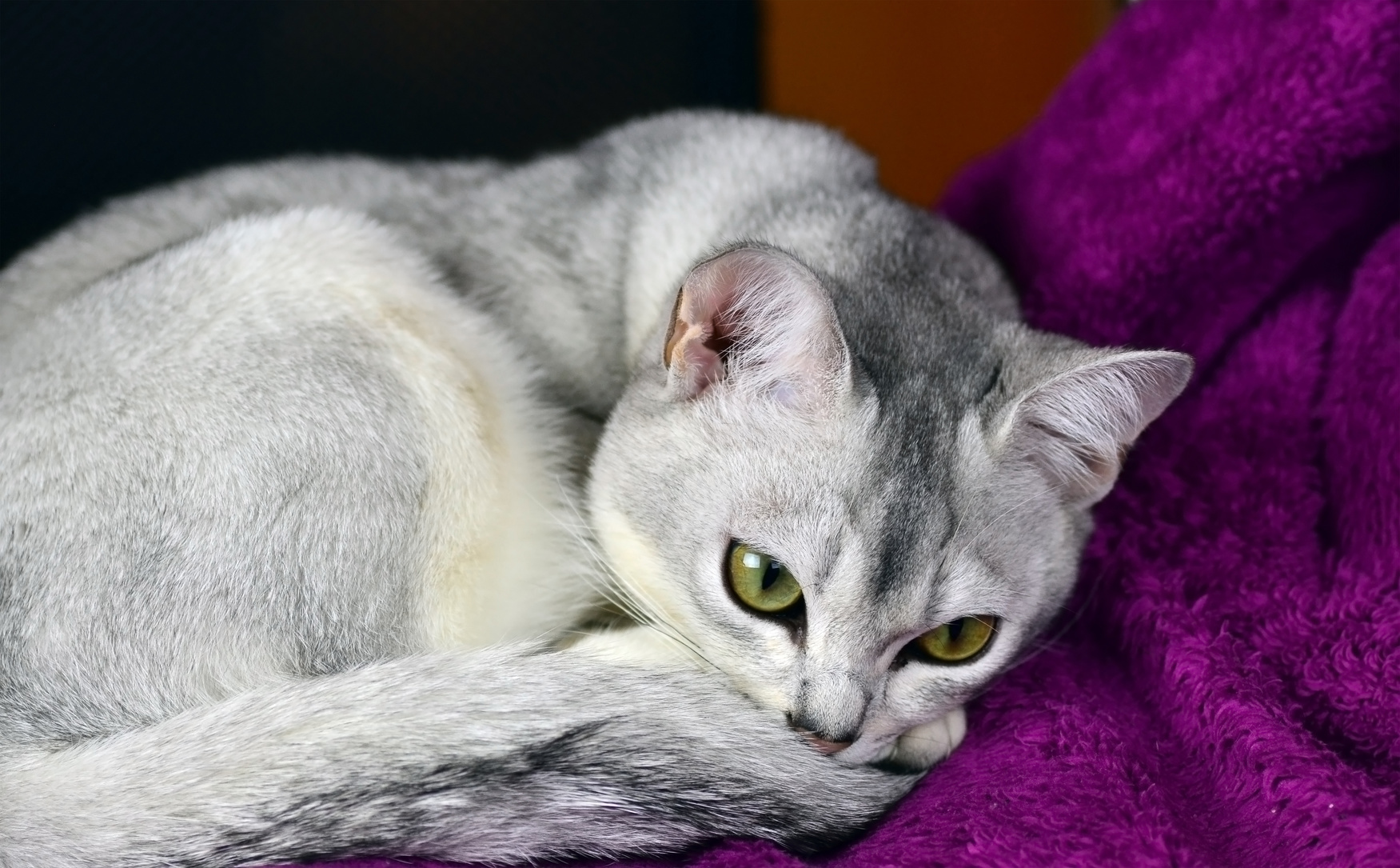Maine Coon
The Maine Coon has become one of the most popular cat breeds in the world. This is probably due to its majestic appearance, robust nature and great character.
This playful and still new British cat breed came about through a chance crossing of a Chinchilla Persian cat and a Burmese. There are several myths surrounding the origin of the breed, of which one is cuter and more heart-warming than the other – just like the Burmilla itself.

This beautiful cat with shimmering silver fur is in principle also well suited to being kept in an apartment with limited space. However, the Burmilla also appreciates being able to have a few outdoor adventures and happily integrates itself with a family.
The name Burmilla indicates the two breeds involved in its creation: the Burmese and the Chinchilla Persian.
The onset of the Burmilla in 1981 sounds like a love story, or rather a cat romance or feline fairy tale. Once upon a time, there was a Chinchilla Persian cat called Sanquist and a lilac-coloured Burmese called Faberge. Due to the oversight or sympathy of a maid, since the animal was locked in the bureau of the English Baroness Miranda von Kirsbergh – there are varying accounts – Sanquist then managed to seek out Faberge.
According to one tale, the baroness herself kept both breeds. Another version claims that one of the Baroness’ Burmese cats escaped in order to mate with the Chinchilla Persian belonging to a neighbouring property.
We will probably never find out what actually happened. However, an indisputable fact is that the first Burmilla kittens were later born as a result. The kittens of this breed that came out by chance were very strong, expressive personalities with shimmering silver fur. This will later become one of the hallmarks of these striking beauties.
The Burmilla Cat Club was founded at the start of 1984, whereby the slow but steady rise of the breed commenced. An own organisation accepted the Burmilla following the chance creation of the breed. Recognition by the FiFe (“Fédération Internationale Féline”) followed in 1996.
 © dizfoto1973 / stock.adobe.com
© dizfoto1973 / stock.adobe.com
When it comes to the Burmilla’s physique, the greatest similarity possible with its Burmese ancestors is aspired to. They are small to medium-sized in terms of stature. The physique is both elegant and strong and muscular, with the Burmilla reaching from 3 to 6kg in weight.
The chest is very broad, the legs are slim and the paws are dainty. The rear legs are somewhat longer than the front legs.
The Burmilla’s characteristic external features are its sparkling silver fur and unmistakeable “make-up” that outlines and accentuates its nose, lips and expressive eyes. It looks as if someone had generously applied kohl pencil around the eyes of these shimmering beauties.
The base colour of the fur is pure silver-white with tipping in “shaded” or “shell” tones. Black, blue, chocolate, lilac, cinnamon, fawn, silver, red, creme-silver and fawn-tortie-silver are officially recognised fur colours.
There are two different fur lengths for the Burmilla: semi and full-length. On the GCCF (Governing Council of the Cat Fancy) – one of the oldest European umbrella organisations of cat associations – the semi-length fur is called “Tiffanie”. The Burmilla’s fur has a beautiful soft texture.
The recessive gene responsible for long hair was assumed by the Chinchilla Persian. These cats have soft, silky semi-long fur following the line of the body. The tail is long and feathery with this variety of the Burmilla.
The gene responsible for the version with short fur is dominant. Hence, if genes for short and long fur are present, the gene for short fur prevails. A short-haired Burmilla always develops as a result.
The Burmilla has a round head with a prominent jaw. More precisely, the tip of the head is slightly rounded, the head is wide up to eye and jaw level and it tapers to a short and blunt wedge. The nose and tip of the chin are ideally set in a line.
The eyes of this cat breed are allowed to have an arbitrary green tone. During the cat’s youth, the eyes are mostly green-gold to yellow, with the green decreasing as the cat gets older.
The overall appearance is slightly comparable to that of the Burmese though with a “cuter” expression that reflects the childlike aspect.
The Burmilla is very peopled-focused and truly develops unconditional love for its owner. If it lives with a family, it forms a very intense bond with all family members, not just one individual. The same applies within its feline family.
With a great need to communicate and pleasant affectionate nature, the Burmilla constantly looks to be closer to its human housemates. At the same time, it also showcases other typical cat characteristics. For all its affection, the Burmilla is also independent and very demanding – qualities that mark out Burmese cats too.
With the Burmilla, characteristics of Burmese cats like affection and a need to communicate are mixed with the relaxed and uncomplicated nature of the Persian cat. The Burmilla is the perfect mix, as it is sociable, playful and loving. It also has a remarkable intuition for the humans in their surrounding area and can sense when things aren’t going so well for “their” people.
For all their seismographic sensitivity and calm, gentle nature, Burmilla cats love having fun and maintain their playfulness into old age. They get on well both with other animals and with children. Being kept together with other cats mostly complements their nature – especially when the owner has to be out all day at work.
The Burmilla doesn’t like spending time alone. If you’re considering bringing such a wonderful creature into your home, you should be able to devote enough time to keeping it entertained. You yourself will also have fun and relax in doing so.
These cats with silky silver fur have an intelligent temperament with a real thirst for knowledge. It is easy for them to learn tricks thanks to their high intelligence. Although they don’t need too much space for frolicking and romping around, a climbing wall (you can even make one yourself), scratching board or cat tree with the possibility to climb – or ideally several – should definitely be available for sharpening the claws and stretching the muscles. This brings about species-appropriate living conditions and is guaranteed to make your feline friend feel at ease with you.
You can maintain the fur’s characteristic shimmering silver shine by giving your beloved cat high-quality food. In contrast, low-quality food that is difficult to digest can lead to a vitamin and mineral deficiency. In turn, this causes a lack of shine and the fur appearing in worse condition overall.
It is important to provide food with a high meat content, because the natural cat diet consists of mainly meat. Other factors to consider are age, health status and the amount and type of the cat food.
Whether you choose dry cat food or wet cat food, it is important to pay attention to quality. Other diets we would recommend are BARF and home-cooked meals, but not without getting reliable information from trustworthy sources.
Your veterinarian can also give you advice on your cat’s diet.
 © SynchR / stock.adobe.com
© SynchR / stock.adobe.com
The Burmilla’s fur is very easy to maintain, but it does enjoy being brushed by its human housemate. By doing so, you also prevent the fur from felting, as the fat content is distributed across the entire coat. For this reason, you should take the time once a week to groom your feline friend.
The fur fulfils important functions as well as being attractive to look at and touch. It transmits sensory information to the cat and protects it from the heat and cold and wind and rain. As well, vitamin D is produced through the fur.
Excess weight can be another cause of your cat not being able to reach all parts of its body for grooming – and the fur consequently being less neat and shiny. The same applies when the cat can no longer readily reach all parts of its body due to old age, because it may have arthritis or its physical flexibility may simply be limited.
Bathing your cat too frequently can also damage the fur. As well, dull fur can be an indicator of more serious ailments like diabetes, parasite infestations, allergies, an autoimmune disorder or the like.
In any case, allergies can emerge more frequently amongst Burmilla cats than with other breeds. There can be many triggers, of which the most common are fleabites and environmental allergens like pollen, dust mites and mould spores. A pollen allergy only comes to the fore during periods of high pollen count. Some foods can also cause allergic reactions for cats, such as those containing wheat, beef or fish. Additives like colourings and preservatives can sometimes trigger allergies and should be fundamentally avoided as far as possible.
Even fragrances and colourings in cleaning products can lead to your cat suffering from allergic symptoms.
Your vet can carry out an allergy test in order to identify what substances trigger an allergic reaction for your cat. If they are allergic to certain food components, you can find this out for yourself easily by giving your cat food as an experiment that contains none of the ingredients suspected to trigger an allergy. Your trusted vet knows what can be done with regard to treating a potential allergy. In principle, homoeopathy has also proved a success for cats.
There is also a statistically more common occurrence of kidney disease with the Burmilla. As a potential new owner, you should use the family tree to be sure that no serious kidney problems have emerged in the past. Were this the case, it would increase the probability of your cat also suffering from the same issues.
At present, there are still few Burmilla breeders.
Generally speaking, the same criteria as with other cat breeds apply when it comes to choosing the right breeder for the Burmilla.
If a supposed breeder is offering cats without paperwork, you should absolutely refrain from making a purchase.
Form an impression of the breeding conditions. How do the cats seem to you? Are they open and even-tempered or anxious? How do they look? Do they have abnormalities with their appearance like clotted or swollen eyes? The latter should absolutely not be evident under any circumstances.
A serious breeder stands out by belonging to an association or club connected to the FiFe. In addition, they will be able to show you the cat’s family tree and will voluntarily give you your own copy.
There are nowadays reliable tests to identify genetic deficits. In future, these will probably be compulsory.
Of course, for all the breeder’s diligence and attention, it can still be the case that not all kittens from a litter are healthy.
A trustworthy breeder remains interested in its kittens’ wellbeing after giving them away and remains available to you for questions once the kittens are with you.
| Origin | Accidental breeding of Chinchilla Persian and Burmese in the 1980s |
| Coat | Medium-haired, dense, silky, soft, and plush with a thick undercoat |
| Color | Solid: silver, shaded & shell (black, blue, chocolate, lilac, cinnamon, fawn). Bi-color & tortoiseshell with silver are also recognized |
| Eyes | Greenish-gold |
| Temperament | Intelligent, people-oriented, affectionate, playful, calm, and sociable |
| Care | Requires regular brushing to maintain coat |
| Health | Generally healthy, but may be prone to hereditary kidney problems. Consider pedigree research before adopting |
| Price | Euro 1,000 – 1,500 |
Here are some purchase proposals curated by the zooplus editorial team
The products featured have been carefully selected by our editorial staff and are available at the zooplus online pet shop. The selection does not constitute advertising for the mentioned brands.
The Maine Coon has become one of the most popular cat breeds in the world. This is probably due to its majestic appearance, robust nature and great character.
Large eyes and attentively upright ears instantly tell you a great deal about this charming breed of cat: Abyssinians are inquisitive and affectionate towards people.
With its long, dense fur, rounded ears, and intense stare, the Pallas Cat, or Manul, looks rather fluffy, yet somewhat dangerous. However, don't be fooled by its appearance—this is no petting zoo resident. The Manul is a wild animal and considered untameable.